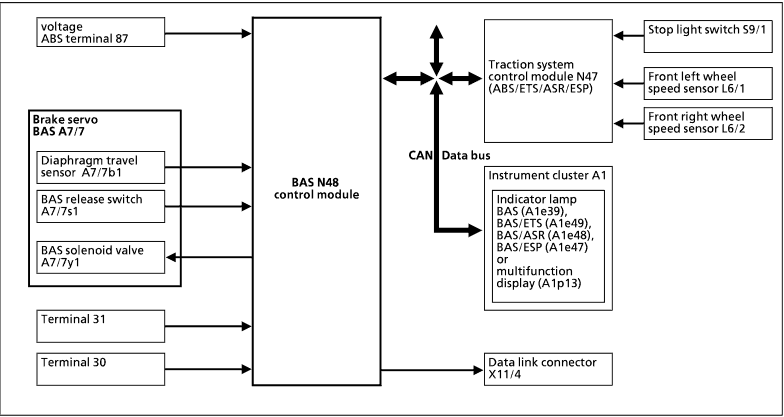
| GF42.31-P-2000A | BAS brake application function | 25.6.96 |
| ||||||||||||||||||
 |
| The functions of the BAS brake servo (A7/7) are controlled using the components of the electric/electronic system.
In model 168, the voltage supply for the BAS control module (N48) is via the fuse and relay box (F1). In models 129 and 140 via the base module (N16/1). In models 163, 170, 202, 208, 210, 215, 220 via the relay module (K40). In model 203 via the SAM control module (N10/1). 
In all vehicles with engines 112, 113, 605, 606, 611, 612, 613 and ESP, the BAS control module function is integrated in the ESP control module (N47-5). In models 163, 168, 203, 215, 220, the BAS control module function is integrated in the ESP control module (N47-5). The BAS control module receives input signals from the following components:  ME control module (via CAN data line) ME control module (via CAN data line)
 Traction system control module (via CAN data line) Traction system control module (via CAN data line)
 BAS diaphragm travel sensor BAS diaphragm travel sensor
 BAS release switch BAS release switch
|
In the BAS control module, the input signals are converted into output signals for the following components:
 BAS solenoid valve BAS solenoid valve
 BAS/ESP malfunction indicator lamp (via CAN data line) BAS/ESP malfunction indicator lamp (via CAN data line)
On the basis of the input signals, the BAS (N48) or ESP (N47-5) control module decides which of the 3 operating modes  Normal operation Normal operation
 BAS pressure increase BAS pressure increase
 BAS pressure reduction BAS pressure reduction
is to be activated. Normal operation In this case, the brake application is not at the higher pedal speed (that requires activation of BAS). The solenoid valve in the BAS brake servo (A7/7) is de-energized in the basic position. The system is ready for braking. Service brake and ABS function normally. This mode is also set if there is a fault in the BAS. |
| BAS pressure increase
From the speed of the brake pedal, the BAS control module (N48) recognizes that the preconditions exist for activation of BAS. The BAS solenoid valve (A7/7y1) is activated by the BAS control module (N48) and the brake servo produces the maximum brake assistance power. BAS is activated when the following conditions exist simultaneously:  Speed >8 km/h Speed >8 km/h
+ BAS release switch is operated + no fault is currently detected + the system is enabled (after self-test) + the activation threshold of the pedal speed has been exceeded |
BAS pressure reduction
The BAS control module (N48) receives information from the BAS release switch (A7/7s1) that the emergency brake application has terminated. The BAS solenoid valve (A7/7y1) is no longer activated and the maximum braking assistance force is switched off. The normal braking assistance force remains unchanged. BAS is switched off when one of the following conditions exists:  BAS release switch is not actuated BAS release switch is not actuated
 Speed <3 km/h Speed <3 km/h
 Duration of activation >20 s Duration of activation >20 s
 If no signal from the stop light switch is present after activation of BAS If no signal from the stop light switch is present after activation of BAS
 A fault is detected that causes the BAS malfunction indicator lamp to be activated A fault is detected that causes the BAS malfunction indicator lamp to be activated |